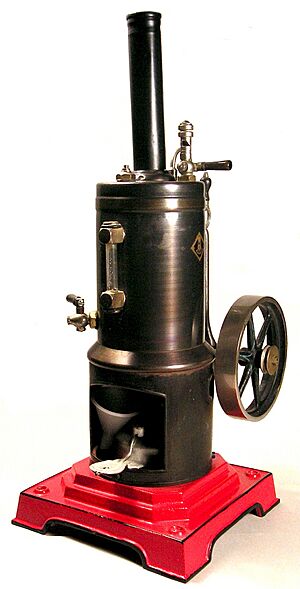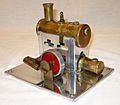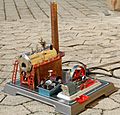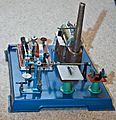Model steam engine facts for kids
A model steam engine is a small version of a real steam engine. These tiny engines are not built for big jobs like powering trains or factories. Instead, they are often made as educational toys for kids to learn how steam power works. Many adults who love steam engines also build or collect them as a hobby. Long ago, between the 1700s and early 1900s, these models were even used in universities and engineering schools to teach students about how engines operate.
People make model steam engines in many different ways. Some companies sell them ready-made, but many adults who enjoy steam engines like to build their own from scratch. To do this, they often need special tools like a lathe (for shaping metal) or a milling machine (for cutting metal). If someone doesn't have these tools, they can buy parts that are already made and then put them together.
Contents
What Makes Model Steam Engines Special?
Simple Toys vs. Detailed Models
Toy steam engines are usually simpler. They might not have all the fancy parts that real engines do, like special oil systems or speed controls. They also run at lower pressures, which means they are safer for kids.
More detailed model steam engines try to look and work just like real, full-sized engines. Companies like Wilesco make both simple toy engines for beginners and more complex models. These detailed models can even power small workshops or boats!
How Do They Get Hot?
Model steam engines need heat to make steam. They can use different types of fuel:
- Hexamine fuel tablets: These are small, solid fuel blocks.
- Methylated spirits: This is a type of alcohol that burns easily.
- Butane gas: Like the gas used in lighters.
- Electricity: Some models use an electric heater.
Moving Parts and Features
The main part of a steam engine is the cylinder, where the steam pushes a piston. In models, cylinders can be:
- Oscillating: These cylinders rock back and forth as they work. They can be single-acting (steam pushes from one side) or double-acting (steam pushes from both sides).
- Fixed: These cylinders stay still. They use special valves like slide-valves, piston valves, or poppet valves to control the steam. These are usually double-acting.
Other common parts you might find on a model steam engine include:
- Safety valves: These are important! They release steam if the pressure gets too high, keeping the engine safe.
- Steam whistles: Just like on a real train, these make a fun sound!
- Feedwater pumps: Some larger models have these. They pump water back into the boiler, so the engine can run for a very long time without needing to be refilled.
Gallery
Images for kids








